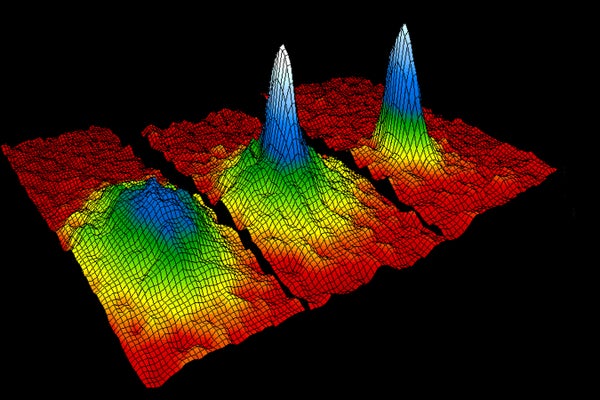A bizarre state of matter just got weirder — and more useful. Physicists have succeeded in cooling down molecules so much that hundreds of them lock in step, making a single gigantic quantum state. These systems could be used to explore exotic physics, such as by creating solid materials that can flow without resistance, or could form the basis of a new kind of quantum computer.
Physicists have made similar states, known as Bose–Einstein condensates, with atoms since 1995, and used them to understand a wide variety of quantum phenomena. But they have also longed to make such condensates from stable molecules. Molecules interact in more-complicated ways than atoms, offering much richer opportunities for research and quantum technologies. But they are also much harder to cool to the billionths of a degree above absolute zero needed to create a condensate.
“Physicists have been trying to realize Bose–Einstein condensates of molecules for more than a decade,” says Giacomo Valtolina, a physicist at the Fritz Haber Institute in Berlin. The research, published in Nature on 3 June, is “the first to achieve this goal,” he says. “This paper is super exciting.”
On supporting science journalism
If you're enjoying this article, consider supporting our award-winning journalism by subscribing. By purchasing a subscription you are helping to ensure the future of impactful stories about the discoveries and ideas shaping our world today.
Strange behaviour
Quantum physicists predicted in the 1920s that, when cooled down to close to absolute zero, matter would start to behave in strange ways. Heisenberg’s uncertainty principle says that the more precisely a particle’s momentum is known, the more uncertain its position is. If matter is cooled so much that is almost stationary, uncertainty in its position balloons. Once uncertainty becomes greater than the distance between the particles, they become indistinguishable and overlap to occupy a single, lowest-energy quantum state — a Bose–Einstein condensate.
This system displays collective quantum behaviour that is well controlled and at a macroscopic scale, which allows researchers to use it as a playground to simulate phenomena such as exotic kinds of magnetism and the emission of Hawking radiation from a model black hole. Condensates have been used as quantum sensors and atomic clocks, and even gone into space.
Molecules are much more complicated than atoms, says Sebastian Will, a physicist at Columbia University in New York City, who led the latest work. They can rotate and vibrate in ways that are impossible for atoms, and polar molecules — which have positively and negatively charged ends — can interact over long ranges through electromagnetic forces. Because these long-range interactions “define the property of matter around us,” a molecular condensate would allow physicists to simulate and understand a much wider array of phenomena, he says.
But there’s a catch. “Compared to atoms … molecules are more difficult to control and cool,” says Zoe Yan, a physicist at the University of Chicago in Illinois.
Loosely-bound structures known as Feshbach molecules have been cajoled into condensates before. But in stable molecules, the final stage of cooling, to turn clouds of them into a condensate, has been scuppered by chemical reactions between colliding molecules. These interactions heat the molecules and cause them to escape the cloud, leaving too few to work with.
Will and his team found a way to prevent these collisions in a cloud of polar molecules, each made from one sodium and one caesium atom. The team applied two different kinds of microwave fields to the cloud, one to make the molecules rotate and another to make them oscillate. Together these fields oriented the molecules such that they always repelled each other. “This turned out to be absolutely crucial,” says Will.
This repulsion prevented collisions, allowing the team to further chill the molecules — by forcing out the hottest ones — without losing too many. The result was a condensate of more than 1,000 molecules, cooled to 6 billionths of a degree above absolute zero. The hallmark of a Bose–Einstein condensate “is clearly shown,” says Valtolina.
The results are “fantastic,” says Yan. They will “really inspire and stimulate the rest of the cold-molecules community.”
Exotic phases
Molecular Bose–Einstein condensates could be used in myriad ways. One possibility, says Valtolina, is to create exotic supersolid phases, in which a rigid material flows without resistance. So far this has been achieved only in atomic gases with magnetic interactions — it could now be done in polar molecules, whose interactions are “way stronger,” he says.
Physicists will also be able to test predictions about how this strange matter will behave. Will says that by tuning the microwave fields to allow some interaction between molecules, the team expects to see the system separate into quantum droplets, a new phase of matter. By confining the condensate in two dimensions using lasers, the team also hopes to watch while the molecules arrange themselves, under a microscope, to form a kind of crystal. “That’s something that has never been possible,” says Will.
The condensate molecules could also form the basis of a new kind of quantum computer, adds Will. Given that each molecule is in an identical, known state, they could be separated to form quantum bits, or qubits, the units of information in a quantum computer. The molecules’ quantum rotational states — which can be used to store information — can remain robust for perhaps minutes at a time, allowing for long and complex calculations.
The reaction to the paper has “been something I’ve never experienced before,” says Will. “People really love the potential of this.”
This article is reproduced with permission and was first published on June 3, 2024.
